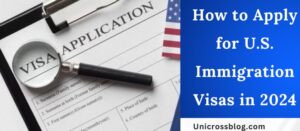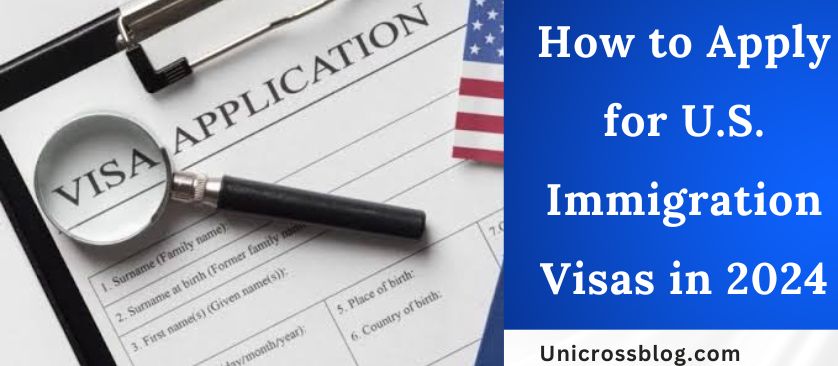In 2024, applying for a U.S. immigration visa may appear daunting, but with careful preparation and diligent attention to detail, you can successfully navigate the process. This guide will walk you through the updated requirements for different visa categories, what documents and forms you’ll need to submit, how to complete your application, and tips for your visa interview at the consulate. Whether you’re seeking work authorization, family reunification, or another immigration benefit, you’ll find the key steps outlined here to increase your chances of approval. Following the recommendations in this article will help ensure your visa application is complete, compliant, and compelling.

What is Immigration Visa?
An immigration visa is an official document issued by the U.S. government to foreign nationals seeking to enter the U.S. for the purpose of residency. These visas are issued by U.S. embassies and consulates abroad. There are several types of immigrant visas available based on your reason for immigration. The most common types are family-based visas and employment-based visas.
Family-Based Immigrant Visas
Family-based immigrant visas allow U.S. citizens and lawful permanent residents to sponsor certain family members for immigration to the U.S. The categories include immediate relatives (spouses, children, parents), family preference (adult children, siblings), and relatives of U.S. citizens. The application process involves filing a family-based visa petition, application forms, documents proving the family relationship, and an interview.
Employment-Based Immigrant Visas
Employment-based immigrant visas require an employer to sponsor a foreign worker to work in the U.S. permanently. The categories include priority workers (with extraordinary abilities, outstanding professors and researchers, multinational executives and managers), professionals with advanced degrees, skilled workers, special immigrants, and employment creation immigrants. The employer must obtain a labor certification and file an I-140 immigrant petition to establish that there are no qualified U.S. workers for the position. The foreign worker must also file application forms and documents and attend an interview.
Importance of Immigration Visa
An immigration visa is crucial for anyone wishing to enter the U.S. for an extended period of time or with the intention of eventual permanent residency.
Eligibility
To be eligible for a U.S. immigration visa, you must meet certain requirements related to your nationality, family relationships, employment skills, and financial stability. The type of visa you need depends on the purpose of your stay. Do thorough research on the various visa categories to determine which is most suitable for your situation.
Application process
Applying for a U.S. immigration visa involves multiple steps, so make sure to allot sufficient time to complete the entire process. You will need to submit various application forms, documents proving your eligibility, medical examinations, and an interview. Fees are required for most application forms and processing. Carefully follow all instructions to avoid delays or denial of your application.
Interview
As part of the application process, you will be required to attend an interview at a U.S. embassy or consulate. Come prepared to answer questions about your reasons for immigrating, your eligibility for the specific visa, and your intentions to leave the U.S. (for nonimmigrant visas). Be ready to provide additional documentation to support the information in your application. Dress in professional, conservative attire and be polite, honest, and confident during your interview.
Timelines and restrictions
The processing time for an immigration visa application varies depending on the specific visa category and annual quotas. Most applicants can expect to wait at least 6-18 months for a decision. Once approved, your immigration visa will allow you to travel to a U.S. port of entry where you will be inspected by a border official to determine if you are admissible. There may be restrictions on the duration of stay, employment, and travel outside the U.S. depending on your visa type.
An immigration visa provides an opportunity to build a new life in America. However, it is a privilege that comes with responsibilities. Educate yourself on U.S. laws and policies, and do your part to positively contribute to the communities in which you settle. With hard work and perseverance, you can achieve your dreams of becoming a legal permanent resident.
U.S. Visa Types and Requirements
Immigrant Visas
Immigrant visas are for people seeking to immigrate to the U.S. permanently. The most common types are family-based visas and employment-based visas. To apply for an immigrant visa, you must first submit a petition to USCIS. Once approved, you can continue the process through the Department of State. Requirements include submitting various forms and documents such as proof of relationship to a U.S. citizen or lawful permanent resident (for family visas), or an approved labor certification or job offer (for employment visas). Processing times can vary significantly based on the specific visa category.
Nonimmigrant Visas
Nonimmigrant visas are for those seeking to enter the U.S. on a temporary basis, such as tourists, students, business travelers, and temporary workers. The requirements and application process depend on the specific visa type. For example, to apply for a B-1 business visitor or B-2 tourist visa, you need to submit Form DS-160, a photo, your valid passport, and proof of funds for your trip. Student visas (F-1) require acceptance from a U.S. school, proof of financial support, and an interview. Temporary work visas like the H-1B require a U.S. employer to file a petition to establish that no qualified U.S. workers are available for the position.
Visa Waiver Program
The Visa Waiver Program allows citizens of certain countries to travel to the U.S. for tourism or business for up to 90 days without a visa. To use the VWP, you must have an e-passport, obtain ESTA travel authorization prior to travel, and meet other eligibility criteria regarding the purpose of your trip. While convenient, the VWP does not allow for any extensions of stay or changes of status. If you plan to study, work, or remain in the U.S. longer than 90 days, you will need to apply for the appropriate visa.
Application Process
The application process typically involves submitting various forms, documents, photos, and fees to the U.S. government, either to USCIS for petition-based visas or directly to a U.S. embassy or consulate for nonimmigrant visas. Most applications require an in-person interview as well. Applicants should start the application process as early as possible due to potential processing delays and backlogs for some visa types. Hiring an immigration attorney to help guide you through the process can help ensure applications are complete and correct the first time.
Step-by-Step Guide to Applying for a U.S. Visa
To apply for a U.S. visa, you will need to follow several steps. First, determine which type of visa you need based on the purpose of your travel to the U.S. The most common nonimmigrant visas are tourist visas, student visas, and work visas. Once you know the appropriate visa category, you can start the application process.
Gather the Required Documentation
You will need to submit various documents to support your visa application. These typically include:
- A valid passport: Your passport must be valid for at least six months beyond your intended stay in the U.S.
- A photo: You will need a 2-inch by 2-inch photo of yourself against a plain white background. The photo must have been taken within the last six months.
- A visa application form: Form DS-160 is required for most nonimmigrant visa applicants. You must submit it online and print the confirmation page to bring to your interview.
- Proof of funds: Evidence that shows you have sufficient funds to cover your trip, such as bank statements for the last few months. The amount required depends on the specific visa type.
- Additional documents: Specific visas may require extra documents like proof of enrollment in school (for student visas) or a letter from your employer (for work visas). Check the requirements for your particular visa.
Schedule an Interview
Once you have gathered the necessary paperwork, you must schedule an interview appointment at the U.S. embassy or consulate in your home country. Wait times for interviews vary, so schedule as early as possible. At the interview, a consular officer will evaluate your application, supporting documents, and the purpose of your trip to determine if you qualify for the visa. They may ask you questions about your intended activities in the U.S. to assess your credibility.
Visa Decision and Next Steps
If your application is approved, your passport with the visa will be mailed to you or available for pick-up, depending on the specific embassy or consulate. If denied, you will receive a letter explaining the reason for denial and next steps for potentially reapplying. It may take several weeks to receive your passport after the interview. Make sure to account for processing times so you have your visa in hand before any scheduled travel.
Following these steps carefully and being well-prepared for your interview will maximize your chances of obtaining the U.S. visa you need for your trip. Best of luck!
READ ALSO: Job Opportunities in Gulf Countries with Visa Sponsorship 2024
FAQs
What types of immigration visas are available?
The U.S. offers various types of visas for immigration purposes. The most common are:
- Family-based visas: For U.S. citizens petitioning for family members. Includes visas for spouses, children, parents, and siblings.
- Employment-based visas: For U.S. employers seeking to sponsor foreign workers. Includes visas for priority workers, professionals with advanced degrees, skilled workers, religious workers, and certain other workers.
- Refugee and asylum visas: For those fleeing persecution or in fear of persecution. Refugees apply from outside the U.S., while asylum seekers apply once they have entered the country.
- Diversity visas: For applicants from countries with historically low rates of immigration to the U.S. Up to 55,000 green cards are allotted each year through the diversity visa lottery.
- Other visas: Including visas for victims of crimes (U visas), victims of human trafficking (T visas), and other special categories.
What are the basic requirements to qualify for a U.S. immigration visa?
To qualify for most U.S. immigration visas, you must:
- Have a family member, employer, or U.S.-based sponsor to petition on your behalf. Some visas allow you to self-petition.
- Meet the eligibility criteria for the specific visa category. This typically includes requirements related to family relationship, job skills, country of origin, etc.
- Not be inadmissible to the U.S. due to health, criminal, or security issues. You must pass background and medical checks.
- Not violate U.S. immigration laws. Unlawful presence in the U.S. or misrepresentation can bar you from a visa.
- Pay the required government filing and visa application fees. Fees range from $190 to $2,275 depending on the visa type.
- Complete the necessary application forms and submit required documents proving your eligibility. This includes petitions, applications, evidence of financial support, medical exams, etc.
- Attend a visa interview at a U.S. embassy or consulate abroad. Some visa categories require an in-person interview, while others may waive the interview requirement.
- Meet additional requirements specific to your situation. For example, demonstrating exceptional ability for an EB-2 visa or having a compelling need for a waiver.
- Wait for application processing. Most family-based and employment-based green cards currently face significant backlogs and waiting periods due to annual quotas. Priority is given to immediate relatives of U.S. citizens and certain employment visas.








